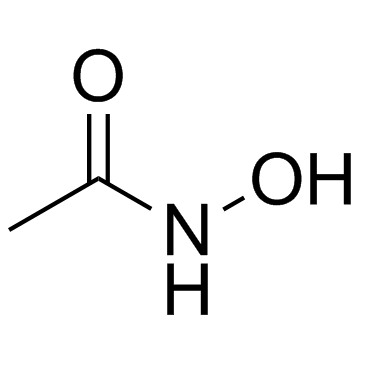Acetohydroxamic acid

Acetohydroxamic acid structure
|
Common Name | Acetohydroxamic acid | ||
|---|---|---|---|---|
| CAS Number | 546-88-3 | Molecular Weight | 75.067 | |
| Density | 1.2±0.1 g/cm3 | Boiling Point | 231.4ºC at 760 mmHg | |
| Molecular Formula | C2H5NO2 | Melting Point | 88-90 °C(lit.) | |
| MSDS | Chinese USA | Flash Point | N/A | |
| Symbol |

GHS08 |
Signal Word | Danger | |
|
CDK1 substitutes for mTOR kinase to activate mitotic cap-dependent protein translation.
Proc. Natl. Acad. Sci. U. S. A. 112 , 5875-82, (2015) Mitosis is commonly thought to be associated with reduced cap-dependent protein translation. Here we show an alternative control mechanism for maintaining cap-dependent translation during mitosis revealed by a viral oncoprotein, Merkel cell polyomavirus small... |
|
|
BDNF stimulation of protein synthesis in cortical neurons requires the MAP kinase-interacting kinase MNK1.
J. Neurosci. 35(3) , 972-84, (2015) Although the MAP kinase-interacting kinases (MNKs) have been known for >15 years, their roles in the regulation of protein synthesis have remained obscure. Here, we explore the involvement of the MNKs in brain-derived neurotrophic factor (BDNF)-stimulated pro... |
|
|
Cheminformatics analysis of assertions mined from literature that describe drug-induced liver injury in different species.
Chem. Res. Toxicol. 23 , 171-83, (2010) Drug-induced liver injury is one of the main causes of drug attrition. The ability to predict the liver effects of drug candidates from their chemical structures is critical to help guide experimental drug discovery projects toward safer medicines. In this st... |
|
|
Identifying chelators for metalloprotein inhibitors using a fragment-based approach.
J. Med. Chem. 54 , 591-602, (2011) Fragment-based lead design (FBLD) has been used to identify new metal-binding groups for metalloenzyme inhibitors. When screened at 1 mM, a chelator fragment library (CFL-1.1) of 96 compounds produced hit rates ranging from 29% to 43% for five matrix metallop... |
|
|
Serum metabolite signatures of type 2 diabetes mellitus complications.
J. Proteome Res. 14(1) , 447-56, (2015) A number of metabolic conditions, including hypoglycemia, high blood pressure (HBP), dyslipidemia, nerve damage and amputation, and vision problems, occur as a result of uncontrolled blood glucose levels over a prolonged period of time. The different componen... |
|
|
De Novo proteome analysis of genetically modified tumor cells by a metabolic labeling/azide-alkyne cycloaddition approach.
Mol. Cell. Proteomics 13(12) , 3446-56, (2014) Activin receptor type II (ACVR2) is a member of the transforming growth factor type II receptor family and controls cell growth and differentiation, thereby acting as a tumor suppressor. ACVR2 inactivation is known to drive colorectal tumorigenesis. We used a... |
|
|
Multi-target spectral moment QSAR versus ANN for antiparasitic drugs against different parasite species.
Bioorg. Med. Chem. 18 , 2225-31, (2010) There are many of pathogen parasite species with different susceptibility profile to antiparasitic drugs. Unfortunately, almost QSAR models predict the biological activity of drugs against only one parasite species. Consequently, predicting the probability wi... |
|
|
Contribution of nuclease to the pathogenesis of Aeromonas hydrophila.
Virulence 6 , 515-22, (2015) Aeromonas hydrophila is a gram-negative bacterium that is widely distributed in aquatic environments and can cause septicemia in both fish and humans. However, the underlying mechanisms leading to severe infection are not well understood. In this study, an A.... |
|
|
mTOR regulates MAPKAPK2 translation to control the senescence-associated secretory phenotype.
Nat. Cell Biol. 17 , 1205-17, (2015) Senescent cells secrete a combination of factors collectively known as the senescence-associated secretory phenotype (SASP). The SASP reinforces senescence and activates an immune surveillance response, but it can also show pro-tumorigenic properties and cont... |
|
|
Effects of Phoenixin-14 on anxiolytic-like behavior in mice.
Behav. Brain Res. 286 , 39-48, (2015) Phoenixin is an amidated neuropeptide, which is widely distributed in brain and periphery regions and is known for its key role in reproduction. Phoenixin-14 (PNX-14), one of the endogenous active isoforms, was reported to regulate pituitary gonadotrophin sec... |